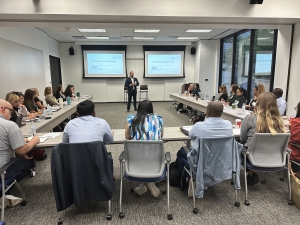BY ENERGY WORKFORCE MEMBER LUKE LEMOINE , PIPER SANDLER
The oilfield outlook for 2024 continues to be constructive and is underpinned by growth in all areas of the oilfield market – U.S. land, offshore and international. The U.S. land rig count is in the process of bottoming, and while it isn’t abundantly clear who will add rigs, there should be some level of a commodity response from smaller private operators as oil prices have risen and AFEs have taken a haircut with service cost deflation.
Based on the current environment, we believe the U.S. land market is capable of growing by ~10% in 2024 from current levels. The broader international and offshore market continues to experience an acceleration in investment that is driven by long-cycle developments, production capacity expansions, and exploration and appraisal. Based on upcoming sanctioning, we believe the international and offshore markets should grow 10-15% next year and will again be led by the Middle East as NOCs in the region continue investing to hit multi-year production targets.
U.S. land has undergone a slowdown this year, and we still refuse to call it a downturn as the rig count wasn’t cut in half and oil service capital discipline has been fairly extreme. During the U.S. rig count increase in 2021 and 2022, we didn’t see oil service companies add much speculative capacity to the market, and during the slowdown, disciplined oil service companies were quick to stack equipment to maintain pricing and returns. At this point, we believe the volatility in the underlying business has been greatly de-risked on both the upside and downside, and there could be a multi-year period of positive returns going forward.
We saw the Baker Hughes U.S. land rig count peak at 764 last year, and it now sits at 600 with the decline being roughly two-thirds oil and one-third gas. The rig count decline was a function of a drop in commodity prices, service costs that remained more elevated than usual due to oil service discipline, acreage constraints and E&P capital discipline. With cost deflation across almost every service line (some more than others) and crude sitting close to $90 per barrel, we believe activity will move higher into year-end and into 2024.
The magnitude of the increase is difficult to determine as E&P capital discipline is firm, and larger private operators in the Permian have had fairly stable drilling programs. We recently hosted panels with five public and large private Permian operators. Between these five, a net increase of two rigs was all that was planned for 2024.
We do believe this is fairly representative of this market segment, and we have been fairly consistent with the opinion that a rig count increase would have to come from the small private operators. In the Permian alone, there have been 30–35 rigs dropped over the past year from operators that just ran one rig and have gone to zero. Layer in the Eagle Ford and some non-shale basins, and we believe this is enough to push the rig count up ~10% from current levels at some point next year.
Permian associated gas growth likely won’t be enough to satisfy demand for 2025 LNG export needs, and there should be a gas rig count response in 2024 as well; however, we find it difficult for the U.S. land rig count to approach last year peak levels of 764 and instead have this peaking in the low 700s in 2025. Even under this assumption, we believe this will be a constructive U.S. land market, capacity can be absorbed, and net pricing should return to OFS.
U.S. oil production growth is capacity constrained, and the swing producer has turned back to the broader international and offshore markets. Investment momentum is accelerating in these arenas and is supported by long-cycle developments (Guyana, Turkey, Norway and Brazil), production capacity expansions (Saudi Arabia, UAE and Qatar), and exploration and appraisal (Africa and the Eastern Mediterranean).
Per SLB, global FIDs are expected to be $500 billion between 2022–2025 with greater than $200 billion coming from deepwater. This year alone, ~$152 billion will be invested in upstream development projects which is up 9% year over year, and almost half of this amount is directed towards offshore. Just in Saudi Arabia, upstream oil and gas investment is expected to be ~$100 billion from 2023-2025, a ~60% increase compared to the previous three years. This is all in an effort to expand nameplate production capacity in the kingdom to ~13 million barrels per day by 2030.
In offshore, floater demand has moved up to 124 from 111 last year, and based on FID demand, we believe this could move to ~150 by 2026. Similarly, jackup demand has improved year over year to 338 from 314, and we believe this could approach the mid 370 level in 2025.
In our opinion, the golden age of offshore and international is making a comeback, and just like U.S. land service companies, capital discipline is the key focus among international and offshore service providers. At this point, we see a multi-year cycle that could see international/offshore annual growth rates of 10-20% over the next few years.
ENERGY WORKFORCE MEMBER
LUKE LEMOINE, MANAGING DIRECTOR & SENIOR RESEARCH ANALYST, PIPER SANDLER
Luke Lemoine is a managing director and senior research analyst covering the oilfield services sector at Piper Sandler, based in New Orleans. Prior to joining Piper Sandler, Lemoine served as a managing director at Capital One Securities for 17 years, where he covered the oilfield services sector in equity research. He’s been recognized as a Rising Star by Institutional Investor and previously worked in energy banking for a predecessor of Capital One. Luke graduated from Louisiana State University with a bachelor’s degree in finance and is a CFA charterholder.




